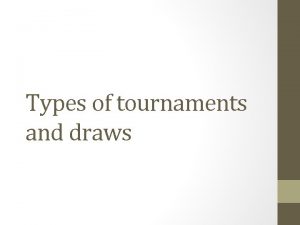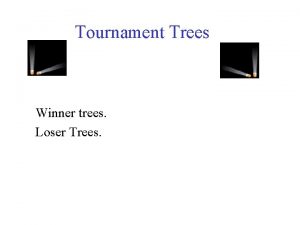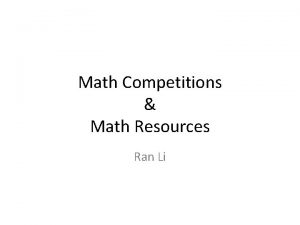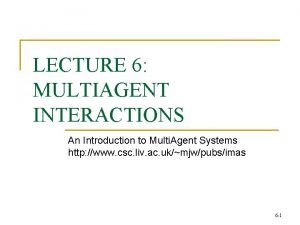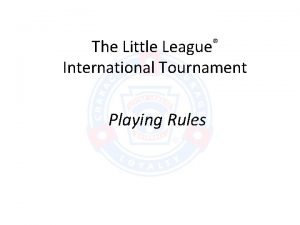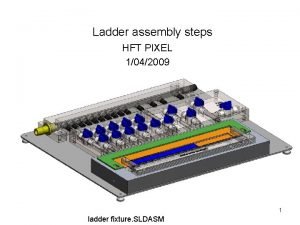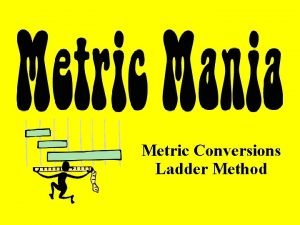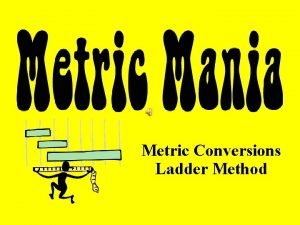Types of tournaments and draws Ladder tournament In



































- Slides: 35

Types of tournaments and draws

Ladder tournament In a ladder tournament players are listed as if on the rungs of a ladder, according to ability or ranking, with the best player at the top of the list. Competition is arranged by challenge and a player is allowed to challenge players above them on the ladder. Usually there is a limit to how many rungs above them players may challenge.

If the lowest-placed player wins the match then the two players change places on the ladder. If the challenged player wins, they are allowed to challenge someone above them before they must accept another challenge.

Note that • All challenges must be accepted and played before a pre-determined date or time • Specific rules should be posted concerning the ladder tournament in order to avoid disputes and to keep the tournament running smoothly • Ideal for maintaining a continuous ranking of players over a long period of time


Advantages • • • Easy to organize. Emphasizes maximum participation. Winning not required staying included. Opportunity for social interaction. No need to maintain win-loss record. Participants play when convenient. Good for ranking participants. No formal schedule. No formula required.

Disadvantages • Communication between participants is required to arrange match. • Lacks challenge for some. • Suited for small number of entries only. • May appear overly complicated to some.

Pyramid tournament

Pyramid tournament Similar to the ladder tournament, the pyramid tournament maintains continuous, prolonged competition. It allows for more challenges to be made and so more participation, and can include a larger number of participants than the ladder tournament.

After the original draw is made, any player may challenge any other player in the same horizontal row. If they win, they can challenge any players in the row above them. When a player loses to someone in the row below them, they change places with the winner. Again, as in the ladder tournament, clear, concise and specific rules should be posted with the challenge board in order to avoid disputes about challenge matches.

Single elimination tournament The simplest type of tournament is the single elimination tournament, in which the winner of each match advances in the tournament and the loser is eliminated. As the name implies, one loss eliminates a player; no provision is made for an ‘off-day’ or bad luck occurring to a player. This type of draw is most convenient with a large number of contestants and only a short time available for play.

If all players are of equal ability or their ability is unknown, all names are placed in a hat and drawn blindly for positions on the draw sheet. The first name drawn is placed on the first line of the draw, the second name drawn is placed on the second line and so on, assuming of course that proper provision has been made for the number of byes required.

If players’ abilities are known, then they are seeded and placed in the draw as for a seeded elimination tournament.

See figure : 1

Figure 1: Eight-team single elimination tournament draw format

Advantages Simple, easily understood. • Determine champion in the shortest possible time. • Require fewer facilities. • Accommodate large entries. • Appropriate for one-day or short-term events. •

Disadvantages • Minimum participation. • Maximum emphasis is on winning. • Champion (or second) may not represent the best players/team. • Does not allow players to have an off-day. • Need to play sequentially (i. e. if one round is lost to weather, all other rounds have to wait until caught up. )

Consolation tournament The consolation tournament is generally tagged onto a single elimination tournament. When teams/players lose in the first round of play they move to a consolation bracket where they compete with each other for the consolation title. The firstround winners stay in the winners’ bracket and compete for the overall championship.

A ‘feed-in’ consolation tournament enables losers from the first round through to losers in the quarter finals to drop down to the consolation bracket to compete for the consolation title

Figure 2: Consolation tournament for single elimination draw format

Double elimination tournament • In a double elimination tournament a team or players must lose twice before they are eliminated. It’s superior to the single elimination tournament when a small number of players are involved (less than eight) for it makes allowances for players having an ‘off-day’. Byes are given for less than eight players. If more than eight players are entered, two separate tournaments can be held and the winners can meet for the championship.

See figure 3:

Loser's bracket

Figure 3: Double elimination tournament draw format with loser's bracket format

Seeded elimination tournament The draw format for this type of tournament ideally has entries of 4, 8, 16, 32, 64 (multiples of 4). If there are: • 8 or 16 entrants, have 4 seeded players • 24 or 32 entrants, have 8 seeded players • 64 and over entrants, have 16 seeded players. Seeds are placed on draw at positions as outlined on the draw sheet.

After seeds have been placed on draw, other players are drawn randomly and placed on draw from top to bottom. If there are not 4, 8, 16, 32, 64 entrants, byes are allocated to seeds in seeded order, for example if there are: • 14 entrants, seeds 1 & 2 have byes • 24 entrants, seeds 1 -8 have byes.



Round robin tournament • This format allows maximum participation as every team/player plays every other participant an equal number of times. The winner of the tournament is generally the team or individual with the most wins.

Advantages • • Popular format. Easy to organise and administer. Able to pre-schedule full event. Each team plays the others. Produces a true champion. Can rank entries at the end of tournament. Postponed games can be replaced as needed.

Disadvantages • Time consuming. • May need a lot of facilities. • Some may default near the end when they know they cannot win. • If entry numbers are too large the tournament may need to be split into pools. • Can end in a draw resulting in an extra play-off. • Doesn’t provide an instant winner.

If teams/players included are to be seeded so that the top teams/players meet in the final round, those teams/players are accorded the appropriate numbers in the draw which would have them meeting in the final round. When pools are required and you are seeding a draw on previous results, the snake seeding system is recommended. In this method, all teams are ranked in order then the teams are placed in pools starting from the left across pools and then reversed from the right until all teams are accounted for, for example:

Round robin snaking seeding method for two pools Pool A Pool B 1 2 4 3 5 6 8 7 9 10

4 -Team Play-off Grand Final Round 1 Match 1 Team 1 vs Team 2 Winner to final Match 2 Team 3 vs Team 4 Loser eliminated Match 3 Loser Match 1 vs Winner Match 2 Winner to final Grand Final Winner Match 1 vs Winner Match 2 Overall winner Grand Final Round 2

5 -Team Play-off Grand Final Round 1 Match 1 Team 1 vs Bye Match 2 Team 2 vs Team 3 Match 3 Team 4 vs Team 5 Loser eliminated Grand Final Round 2 Match 4 Team 1 vs Winner Match 2 Winner to final Match 5 Loser Match 2 vs Winner Match 3 Loser eliminated Match 6 Loser Match 4 vs Winner Match 5 Loser eliminated Grand Final Winner Match 4 vs Winner Match 6 Overall winner Grand Final Round 3
 Consolation tournament
Consolation tournament Darwinator
Darwinator Personification examples in to kill a mockingbird
Personification examples in to kill a mockingbird Chromatin draws together to create
Chromatin draws together to create Compression draws
Compression draws Tenses and retracts scalp
Tenses and retracts scalp Gre
Gre Draws
Draws Metric shuffle ladder
Metric shuffle ladder Challenge tournament examples
Challenge tournament examples Marlon is bowling in a tournament and has
Marlon is bowling in a tournament and has Disclaimer for training material
Disclaimer for training material Tournament tree
Tournament tree Little league affidavit
Little league affidavit Proposal futsal tournament
Proposal futsal tournament Hellenic history tournament
Hellenic history tournament Cricket tournament sponsorship proposal
Cricket tournament sponsorship proposal Ashland sparkler
Ashland sparkler Tournament trees
Tournament trees Opportunity identification example
Opportunity identification example Berkeley math tournament
Berkeley math tournament Andrzej nadolny
Andrzej nadolny Burnsville athletic club
Burnsville athletic club Wrestling tournament checklist
Wrestling tournament checklist Axelrod tournament
Axelrod tournament Berkeley math tournament
Berkeley math tournament Branch predictor
Branch predictor Cyb christmas tournament
Cyb christmas tournament Beach volleyball worthing
Beach volleyball worthing Casra referee
Casra referee Tournament selection
Tournament selection Tournament selection
Tournament selection Tournament branch predictor
Tournament branch predictor Piper classic disc golf
Piper classic disc golf Golf outing planning checklist
Golf outing planning checklist Tournament tree
Tournament tree
